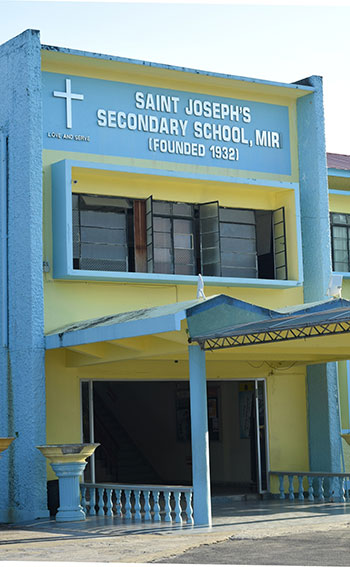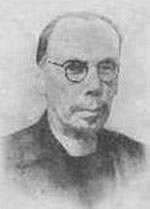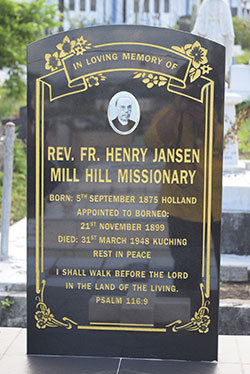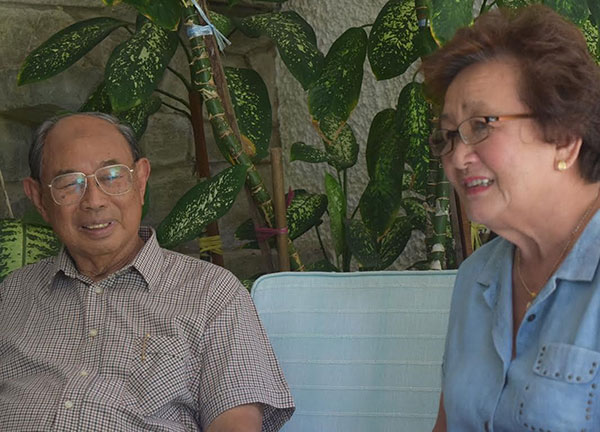
Latest photo of SMK St Joseph Miri.

Rev Fr HENRY Jansen
IN the 1950’s, there was a road in Miri called Jalan Jansen which branched out from Rice Mill Road. Many people used that road from the kampungs and government quarters when they had to go to the central market. Who could this Jansen be, to have a road named after him before the war?
Based on this little memory, a group of old Josephians decided to do more research on Father Jansen, the origin and history of St Joseph’s in Miri. The school will be celebrating its 85th anniversary in 2017.
“It was interesting how the older people remember that a road was named Jansen Road. This has been renamed Jalan Haji Lampam. I have no idea how the road was named after my late father,” Dato Sri Arni Lampan said.
He was speaking to thesundaypost about his childhood in Miri. He grew up in Kampung Dagang and his old house is on the same row as the present KTS office block, opposite Sin Liang Supermarket. The road has been called Jalan Nakoda Gampar since his young days.
He and his brothers went to Rev Father Henry Jansen’s office to visit the thin and frail priest. His father and this Catholic priest were good friends with shared interests. Jansen loved outboard engines and travelling in the Baram.
“Father Jansen, I heard, used to consult my father about outboard engines and he was really keen on the workings of the engines. My father knew a lot about them because he worked for Shell Slipways. Later, my father put all of us in the new school. Within two years, I was able to speak English and given a scholarship to study in Kuching. My future was already designed by God, so to speak. From Kuching, I went to study in Singapore.
“It was amazing how my father and a few other Malay fathers made a decision to put their children in this English and Catholic School, built by Father Jansen. There was already a good school for Malay children — Sekolah Anchi. Perhaps, it was some kind of far-sightedness on our father’s part. The present Tuan Yang Terutama (governor) was amongst those few Malay boys who attended St Joseph’s Primary School, which was then just wooden buildings, very much damaged by the Japanese War.”
According to him, not long after that, he heard that Father Jansen had passed away. That was 1948.
“He was really a small and frail man I remember.”
Catholic Priest and Baram
Jansen, a Mill Hill priest, was not new to Sarawak by the time he started serving in Miri in the 1930’s. He had apparently reached the shores of Sarawak in 1900.
It was mentioned by ‘The Tablet’ that, “Father Jansen left Kuching on April 14 for the Lower Rajang with Father Wensink to assist Father Stotter in the various mission stations which he is now opening there (April 28, 1900).”
His name was mentioned in Peter Metcalfe’s book ‘The Life of the Longhouse’: “Two white men were propagating Christianity in Sarawak and in particular the Baram — Pastor Southwell and Father Jansen. They travelled up the tributaries of the Baram and went even by foot up the mountains to reach the furthest Kenyah, Kayan and Kelabit communities. They were propelled by their belief in God to spread the good news.”
The Sarawak Gazette, October 16, 1919, made an entry: “Father Henry Jansen arrived in Sadong and stayed for a day before going to Sibu by S Alice Lorraine.”
‘The Tablet’ on May 13, 1967, in an article, written by Gerald Mahon, MHM, mentioned Jansen: “We set off early for Long San, which we reached before dark. Here, too, in the chief longhouse families are Catholic. Kenyah life is lived as a community, and a change of religion from paganism is also usually a communal act, preceded by much discussion.
“In Long San it was the Temenggong (chief) himself who called a meeting of all the families to suggest that they should become Christian. He had met many Australians after the Japanese occupation of Borneo and was greatly impressed by them.
“On the other hand, the old adat (custom) of their tribe he blamed for many evils. They all lived in fear — if anyone in the longhouse heard the call of a certain bird during the night, no one might leave in the morning to work in the fields. A dream, the sight of certain animals — all these had their own taboos. Traditional rites at childbirth caused many deaths. The result was a dying race.”
The Temenggong’s words were heeded.
Jansen made the three weeks journey by longboat to Long San with one other priest, taking up residence there. Jansen was sick at the time. And having had the satisfaction of seeing the mission established, he died soon after (in 1948).

Jansen died in Miri and was at first buried behind St Joseph’s Cathedral. Later his grave was shifted to the Riam Catholic Cemetery.
Founding of St Joseph’s School
By 1932, Jansen had been in Sarawak for more than 30 years. Perhaps by then, he thought it was time to start a Catholic school in the then prospering and developing town of Miri.
A souvenir magazine of St Joseph’s states: “He had classes for the boys in a building behind the old St Joseph’s Church while the girls studied at the Convent near the present Department of Agriculture. During the war, most of the school and church buildings were destroyed by Japanese bombing.
“In a way, the school was really not entirely co-educational. It was a unique kind of segregation for boys and girls.”
According to another St Joseph’s magazine: “After the war, classes at St Joseph’s School started in September 1945 and Father Jansen repaired the church and the school. It must have been a lot of hard work for him as only a roof was left over the old church. The teachers had to make do with what was available. For blackboard, teachers used the floor!”
However, within a week after the war, a clubhouse, near the present Gymkhana Club, was found to be suitable as a school. This building was left untouched by the bombings and classes were held there until 1953. Living quarters were added to this house for the priests to live. Many parents were excited about the new school although there was already a Malay school, a Chinese Primary School and St Columba’s Anglican School.
Sadly Jansen passed away in 1948 and was buried behind St Joseph’s Cathedral. Jean Wood had been looking after the school in 1945 and 1946 while parish priests Father Peters and Father Eping also looked after the school for four years and acting as headmasters until Father Dekker came in 1950.
Development of St Joseph’s School
In 1954, the school was expanded and classrooms were converted from Shell quarters at Angsana Road. When this was still inadequate due to an expanding population in Miri, a proper brick building was constructed.
According to Datuk Wan Morshidi Tuanku Abdul Rahman who taught in the school then (after his Form 3), “half of the students had lessons in the old Cathay Cinema which was then called the New Century Theatre”.
When the new school building was completed on May 30, 1954, all the primary and the new secondary school students were able to attend the ‘same school’.
Before 1961, Josephians were only able to complete Form 3. Many of them had to go to Sibu (Sacred Heart School) and even Kuching (St Joseph’s). However, in 1961, Form 4 class was started, jointly for Senior Cambridge in the new St Joseph’s Secondary School at Brighton Road.

Winni and Arni during the interview with thesundaypost.
St Joseph’s Secondary School
It was Father John Dekker who took the initiative to start constructing the secondary
school on its own piece of land, along the then Brighton Road, a little further away from the main town area and the Cathedral. Dekker and his staff initiated the Bricks for St Joseph School fund raising drive. Many Old Josephians remember that fondly. Indeed, St Joseph’s Secondary School was funded by the selling of those brick coupons!
In 1964, St Joseph’s Secondary School was completed at Jalan Temenggong Lawai Jau (Brighton Road), named after a man whose father was the Kenyah chieftain whom Jansen was trying to convert.
Dekker was there to see to the completion of the school’s first block of classrooms.
The new secondary school was declared open on May 31, 1964, by an education officer from Kuching. Named SMB St Joseph, the school was managed by the Vacariate Apostolia of Miri, and funded by the government.
Since the beginning, the school has been multiracial and multi-religious. Different races like the Malays, Chinese, Dayaks, Melanaus, Bisayas, Kayans, and even Indians and Sri Lankans were registered in the school. In 1975, the school saw the first transition classes.
By 1980, the population of the secondary school increased so much that students had to be divided into morning and afternoon sessions.
In 1982, even the Form 2 classes were held in the afternoon, while Form 3 up to Form 5 classes were conducted in the morning.
Before 1982, the medium of instruction was English and by 1987, the medium was fully Bahasa Malaysia. During the interview with thesundaypost, Winni Saba told Arni that new developments were in the offing. Soon the present primary school would be relocated from Pujut Road to share the compound with the secondary school at Brighton Road.
And Old Josephians and the local community will be looking forward to fundraising, maybe something like Dekker’s idea of Bricks for St Joseph’s.
Winni, the organising chair of the 85th Anniversary Reunion, said St Joseph’s School of Miri, is looking forward to celebrating 85 years of history in October 2017.
In an attempt to get a head start before the actual celebration, the organising committee has decided to put into perspective some of the school history, memories, anecdotes, photographs and significant happenings by publishing several articles in the newspapers and a comprehensive souvenir book.
Further details can be found on a specially set up Facebook page and Whatsapp group. May all Josephians continue blazing trails and living up to their motto: ‘Love and Serve’.
